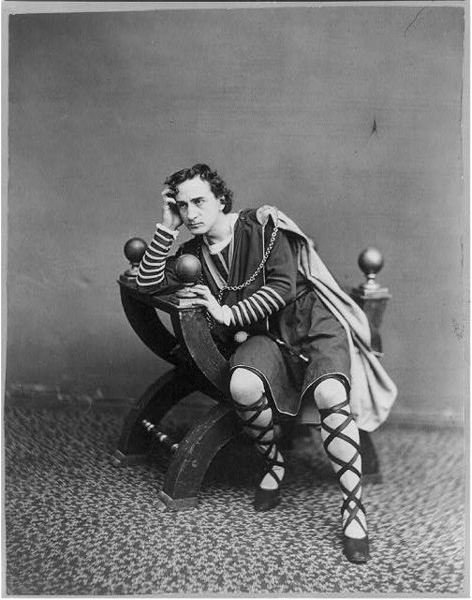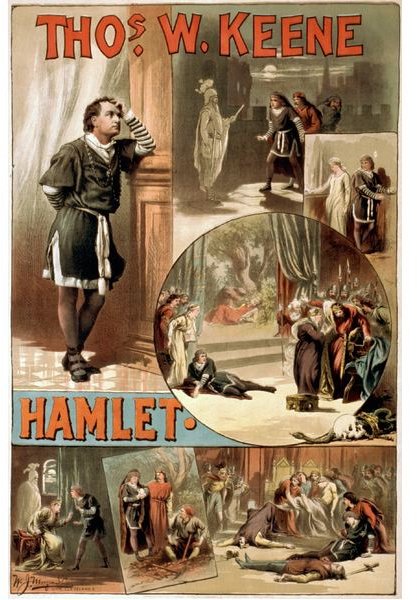Analysis of the Two Main Hamlet Soliloquies: Understand What's Going on in Shakespeare's Famous Play
O, That This Too Too Solid Flesh Would Melt
Let’s begin our look at famous Hamlet Soliloquies with this uplifting message from Hamlet himself:
ACT I, SCENE 2, LINES 129-159
O, that this too too solid flesh would melt, / Thaw and resolve itself into a dew! (130) / Or that the Everlasting had not fix’d / His canon ‘gainst self-slaughter! O God! God! / How weary, stale, flat and unprofitable, / Seem to me all the uses of this world! / Fie on’t! ah fie! ’tis an unweeded garden, (135) / That grows to seed; things rank and gross in nature / Possess it merely. That it should come to this! / But two months dead: nay, not so much, not two / So excellent a king; that was, to this, / Hyperion to a satyr; so loving to my mother (140) / That he might not beteem the winds of heaven / Visit her face too roughly. Heaven and earth! / Must I remember? why, she would hang on him / As if increase of appetite had grown / By what it fed on: and yet, within a month— (145) / Let me not think on’t—Frailty, thy name is woman!— / A little month, or ere those shoes were old / With which she follow’d my poor father’s body, / Like Niobe, all tears:—why she, even she— / O, God! a beast, that wants discourse of reason, (150) / Would have mourn’d longer—married with my uncle, / My father’s brother, but no more like my father / Than I to Hercules: within a month: / Ere yet the salt of most unrighteous tears / Had left the flushing in her galled eyes, (155) / She married. O, most wicked speed, to post / With such dexterity to incestuous sheets! / It is not nor it cannot come to good: / But break, my heart; for I must hold my tongue.
Explanation and Analysis
Explanation: Hamlet begins by stating he wishes to be dead, yet he will not commit suicide for fear of everlasting punishment. He then scorns all that life and the world has to offer, comparing it to an unweeded garden. Beginning with line 136, Hamlet curses his mother for marrying his uncle two months after his father died. Hamlet calls his father an excellent king and his uncle a scoundrel. He then comments that his mother’s affection for his uncle increases, causing Hamlet to curse women in general. He continues to criticize his mother’s quick marriage to an inferior person so soon after his father’s death. Hamlet’s heart his broken and must not speak of his disgust in public.
Analysis: One aspect of Hamlet Soliloquies that makes them so enduring is Shakespeare’s mastery of literary devices. The following literary devices are employed in the above soliloquy.
- Line 129 - Hamlet uses synechdoche, a special type of metaphor that uses a part to represent the whole or the whole to represent the parts. In this example, flesh represents physical life. His flesh melting, thawing and resolving itself into a dew is a metaphor for dying.
- Lines 135-136 - Hamlet uses a metaphor, comparing the world to an unweeded garden that produces things “rank and gross in nature.”
- Line 140: Hamlet uses an allusion to compare his father to his uncle: Hyperion is the Titan god of light in Greek Mythology; satyrs are half man/half beast, usually depicted as man above the waist and a horse or goat below the waist. The implication that Claudius below the waist is a beast is a comment on the new king’s lechery.
- Line 146 - Hamlet uses an apostrophe, speaking directly to “frailty.” This line provides insight on Hamlet’s attitude toward women.
- Line 149 - Hamlet alludes to Niobe, a character in Greek mythology, famous for her ceaseless tears following her children’s death. Hamlet compares the Queen to Niobe immediately following his father’s death, making her marriage to Claudius all the more despicable in Hamlet’s eyes.
- Line 157 - Hamlet uses personification--incestuous sheets–to characterize her mother and her uncle’s relationship. Dexterity in the same line is not void of sexual innuendo.
- Line 158 - Hamlet uses meiosis, or understatement, to end his soliloquy, stating that all this cannot come to good, a mild statement in comparison with the rest of his speech.
“To be or not to be”
ACT III, SCENE 1, LINES 55-87
To be, or not to be, that is the question: (55) / Whether ’tis nobler in the mind to suffer / The slings and arrows of outrageous fortune, / Or to take arms against a sea of troubles / And by opposing end them. To die—to sleep, / No more; and by a sleep to say we end (60) / The heart-ache and the thousand natural shocks / That flesh is heir to: ’tis a consummation / Devoutly to be wish’d. To die, to sleep; / To sleep, perchance to dream—ay, there’s the rub: / For in that sleep of death what dreams may come, (65) / When we have shuffled off this mortal coil, / Must give us pause—there’s the respect / That makes calamity of so long life. / For who would bear the whips and scorns of time, / Th’oppressor’s wrong, the proud man’s contumely, (70) / The pangs of dispriz’d love, the law’s delay, / The insolence of office, and the spurns / That patient merit of th’unworthy takes, / When he himself might his quietus make / With a bare bodkin? Who would fardels bear, (75) / To grunt and sweat under a weary life, / But that the dread of something after death, / The undiscovere’d country, from whose bourn / No traveller returns, puzzles the will, / And makes us rather bear those ills we have (80) / Than fly to others that we know not of? / Thus conscience does make cowards of us all, / And thus the native hue of resolution / Is sicklied o’er with the pale cast of thought, / And enterprises of great pitch and moment (85)/ With this regard their currents turn awry / And lose the name of action.
Explanation and Analysis of Act III, Scene 1, Lines 55-87

Explanation: Hamlet ponders whether or not he wishes to exist, inquiring whether it’s better to struggle through the trials of life or commit suicide. He declares death would be the better option if not for the unknown that death brings. It is this mystery that causes men to suffer through their mortal existence instead of ending their lives.
Analysis: This Hamlet soliloquy uses the following literary elements:
- Line 55 - To be or not to be is an example of antithesis, a rhetorical device containing a contrast of ideas in a balanced parallel construction. The use of antithesis draws attention to the first line of the soliloquy and focuses the reader on one of the play’s prominent themes.
- Lines 59, 60, 61 - Hamlet uses metonymy, a special type of metaphor that substitutes the name of one thing with something it is closely associated with. In these examples sleep represents death.
- Lines 57, 69 - Hamlet uses a metaphor, comparing slings and arrows and the whips and scorns of time to life’s problems.
- Lines 69-73 - Hamlet uses parallel structure, a rhetorical device comprised of phrases with like grammatical structure, to create rhythm and draw attention to life’s woes.
- Line 79 - Hamlet uses a metaphor, calling death “the undiscovered country, from whose bourne no traveller returns.”
- Lines 83-84 - Suicide is referred to as “the native hue of resolution,” a metaphor; the fear of death is referred to as the “pale cast of thought.”
This post is part of the series: Hamlet Study Guide
Review Shakespeare’s greatest play with the Hamlet Study Guide.
